Laser Systems for Compact Equipment are Small But Mighty
Machine control systems that use laser technology are well known in concert with high-production equipment such as large dozers, motor graders, and excavators, but are a bit lesser known when it comes to compact equipment like skid steers, CTLs, and mini excavators.
These systems can save time and money, however, when deployed on smaller machines in the right applications.
The objective behind the systems is to increase productivity, introducing the ability to use compacts for more specialized and finished grading applications. And like the systems for production machines, they’re designed to make things easier on the operator—eliminating the need to exit the cab for grade checks.
For the sources of systems, there are not only the usual suspects in the machine-control field, technology giants Topcon and Trimble and their distributors, but there are also dedicated small-equipment setups available from OEMs and third parties.
Here’s a basic look at a number of the choices available for compacts.
Trimble offers both 2D and 3D systems for skid steers, backhoe loaders, and mini excavators. The 2D GCS900 system is geared as a first investment for contractors new to construction technology.
In grading applications, the system allows the measurement of the lift and tilt of the blade with a single laser and laser receiver. Adding another laser receiver or a slope sensor enables measurement of the slope of the blade. In-cab elevation and slope guidance is designed for operators to make grade more accurately and quickly.
For finished grades, vertical guidance is meant to help the operator achieve tight tolerances and a smooth finished grade. Two angle sensors and a rotation sensor calculate the cross slope of the blade.
The 2D system is upgradeable to 3D as the contractor grows.
In grading applications, the GCS900 3D system measures the position and blade slope with a single GNSS antenna configuration. Operators can also measure the exact position, cross slope, and heading of the blade with dual GNSS.
Above: This Case dozer is outfitted with a 2D Leica system.
For finish grading, the company says the GCS900 can achieve grade to millimeter accuracy in fewer passes.
Skid steer loader market-share leader Bobcat sells automatic grading solutions with a choice of laser-guided systems and sonic/slope systems (top).
The laser-guided systems use a laser transmitter to emit a plane of laser light across the job site. The plane mirrors the completed job site and is used as a reference point to ensure the blade is on grade at all times. The blade moves up and down automatically to keep the base materials on grade. Laser transmitters and rod-mounted laser receivers can also quickly determine the amount of material that needs to be added or removed from the site.
Bobcat offers three laser transmitters: one single-slope model and two dual-slope models. The single- slope transmitter is designed for flatwork or simple grades. Both models of dual-slope transmitters work for a range of jobs from flatwork to compound set-ups.
Each model includes a hand-held laser receiver, and all models feature two-way radio remote control to allow adjustments from across the job site or from within the machine. The laser transmitters also offer temperature compensation, meant to ensure the laser beam stays accurate as temperatures change throughout the day.
The machine control system’s BLR2 receiver uses CANbus communication to provide frequent updates (up to 20 times per second) to the control valve on the attachment for grading purposes. Indicators and an automatic light on the face of the receiver also provide constant information to the operator.
To make grade changes quickly from inside the cab, the “on grade” setting of the receiver can be moved up or down, up to 2 inches with certain machine options, for grading results. The laser receiver can also communicate with the instrumentation of the loader.
The laser control system works with the company’s box blade and grader attachments. Both the box blade and grader work on flat and single slopes. On dual slopes, the grader attachment delivers increased functionality because each side of the blade operates independently.
Designed for use in landscaping, asphalt, and curbs and concrete flatwork, the grader attachment has blades that move six different ways and a front bolster that oscillates 12 degrees to the right or left, allowing for grading on a surface while minimizing the effect of uneven ground. The box blade attachment incorporates end wings to help carry spoil, and it also has elevation control, which allows it to travel up and down slopes.
A key part of Topcon’s hardware for its system is the LS-B10 machine control laser receiver, designed to be a control solution for backhoes, mini excavators, skid steer loaders, and other compact equipment. It features a magnet mount for quick attachment when used on equipment, or it can be combined with the optional Topcon Holder 6 rod clamp for use on a grade rod.
Level Best, a third-party provider, offers three main components: a box attachment, the hydraulic valve, and the laser controls.
Its operation is fairly basic. A rotating laser is set for a desired grade, the rotating beam is read by the laser receiver mounted on a mast pole. The beam’s location is sent to the grade control panel that interprets where the beam of light is in relation to grade.
The control panel then tells the hydraulic valve to adjust the grading box attachment up or down to keep the receiver on grade. This same sequence happens many times per second.
The Level Best system has been used for jobs such as concrete subgrade, parking lots, fine grading, golf course tee boxes, athletic fields, indoor arenas, railroad ballasts, preparing explosive beds for mining, and placing material at curbs and gutters.
Built specifically for compact excavators, EZ Dig Pro Excavator Guidance system has an in-cab control box and remote display that provides the operator with real-time elevation and slope information.
The basic system is comprised of three sensors for the bucket, dipperstick, and main boom, and the control box and main display in the cab. To set up the system, the user attaches the control box and remote display to the excavator cab window with suction cups. Then, plug the cable into a power source, and attach the magnetic, cable-free sensors to the individual elements.
The sensors are battery-driven, with solar cells functioning for power backup, and they communicate via radio.
One of the screens in the cab provides a real-time view of the bucket. EZ Dig says that one of the first calibrations on the machine can be performed solo by the operator. Using the system’s enclosed self-leveling laser pointer, follow the laser to 10 or 15 points on two different elevations, low and high, which the system uses to automatically understand the characteristics and kinematics of the machine, such as the individual elements, lengths, and angles.
The system is able to store five different machines with eight buckets each; to choose or calibrate a new bucket, the operator would press the bucket button. Additional functions include a height and depth alarm, profile mode, and reach information.
Caterpillar’s Grade Control 3D is available for the company’s small 80- to 105-horsepower D3K2, D4K2, and D5K2 dozers (above).
The system automates machine functions during both production-dozing and fine-grading applications. It has an integrated design, including dual, roof-mounted antennas that eliminate the need to climb onto the blade to remove conventional blade-mounted masts and cables. The AccuGrade-Ready Option is part of the package, adding versatility by allowing other Cat Grade technologies to be used, such as AccuGrade Laser or a universal total station when satellite reception is limited. The system assists operators with an in-cab display that shows grade plan, cut/fill data, and grade indicators, improving productivity up to 50 percent, Cat says, compared with conventional grading methods.
There are an increasing number of projects and general contractors that require these systems in project specifications because laser grade control has been proven so accurate.
About the Author
Frank Raczon
Raczon’s writing career spans nearly 25 years, including magazine publishing and public relations work with some of the industry’s major equipment manufacturers. He has won numerous awards in his career, including nods from the Construction Writers Association, the Association of Equipment Manufacturers, and BtoB magazine. He is responsible for the magazine's Buying Files.



